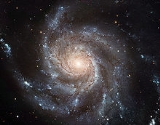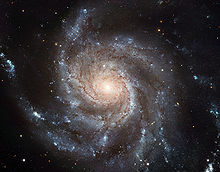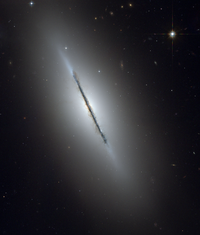
Messier 102
Encyclopedia
Messier 102 is a galaxy
listed in the Messier Catalogue that has not been identified unambiguously. Its original discoverer Pierre Méchain
later said that it was a duplicate observation of Messier 101, but there are historical and observational reasons to believe that it could be NGC 5866
, although other galaxies have been suggested as possible identities.
 Messier 101 (also known as the Pinwheel Galaxy or NGC 5457) is a face-on spiral galaxy
Messier 101 (also known as the Pinwheel Galaxy or NGC 5457) is a face-on spiral galaxy
in the constellation
Ursa Major
. In a letter written in 1783 to J. Bernoulli
, Pierre Méchain
(who had shared information about his discoveries with Messier) claimed that M102 was actually an accidental duplication of M101 in the catalog. This letter was later published twice: First in original French in the Memoirs of the Berlin Academy for 1782, and second in German translation and somewhat rearranged by Johann Elert Bode
in the Berliner Astronomisches Jahrbuch for 1786.
 NGC 5866
NGC 5866
(one of two galaxies commonly called the Spindle Galaxy
) is a lenticular galaxy
in the Draco
constellation
. This galaxy appears to closely match both the object description (by Pierre Méchain
) in the printed version of the Messier Catalog of 1781, and the object position given by Charles Messier
in hand-written notes on his personal list of the Messier Catalogue.
, NGC 5907
, and NGC 5908 are all galaxies near the position of NGC 5866
. By that criterion, they may all be as likely as NGC 5866
to be the objects that correspond to M102. However, none of these galaxies are as bright or as high in surface brightness as NGC 5866, so it is less likely that these objects correspond to M102.
galaxy
located between ο Boötis
and ι Serpentis
. J. L. E. Dreyer, in his Notes and Corrections to the New General Catalogue
, suggested that this may have been the source identified as M102 on the basis that ι Serpentis may have been misidentified as ι Draconis
in the location given for the object. However, it may not have been observable by Messier and Méchain, so it is unlikely to correspond to M102.
Galaxy
A galaxy is a massive, gravitationally bound system that consists of stars and stellar remnants, an interstellar medium of gas and dust, and an important but poorly understood component tentatively dubbed dark matter. The word galaxy is derived from the Greek galaxias , literally "milky", a...
listed in the Messier Catalogue that has not been identified unambiguously. Its original discoverer Pierre Méchain
Pierre Méchain
Pierre François André Méchain was a French astronomer and surveyor who, with Charles Messier, was a major contributor to the early study of deep sky objects and comets.-Life:...
later said that it was a duplicate observation of Messier 101, but there are historical and observational reasons to believe that it could be NGC 5866
NGC 5866
NGC 5866 is a relatively bright lenticular or spiral galaxy in the constellation Draco. NGC 5866 was probably discovered by Pierre Méchain or Charles Messier in 1781, and independently found by William Herschel in 1788.-Dust disk:One of the most outstanding features of NGC 5866 is the extended...
, although other galaxies have been suggested as possible identities.
Candidate corresponding objects
Since the publication of the Messier Catalogue, a number of galaxies have been identified by different historians, professional astronomers, and amateur astronomers as corresponding to M102.Messier 101

Spiral galaxy
A spiral galaxy is a certain kind of galaxy originally described by Edwin Hubble in his 1936 work The Realm of the Nebulae and, as such, forms part of the Hubble sequence. Spiral galaxies consist of a flat, rotating disk containing stars, gas and dust, and a central concentration of stars known as...
in the constellation
Constellation
In modern astronomy, a constellation is an internationally defined area of the celestial sphere. These areas are grouped around asterisms, patterns formed by prominent stars within apparent proximity to one another on Earth's night sky....
Ursa Major
Ursa Major
Ursa Major , also known as the Great Bear, is a constellation visible throughout the year in most of the northern hemisphere. It can best be seen in April...
. In a letter written in 1783 to J. Bernoulli
Johann III Bernoulli
Johann III Bernoulli , grandson of Johann Bernoulli, and son of Johann II Bernoulli. He studied at Basel and at Neuchâtel, and when thirteen years of age took the degree of doctor in philosophy. At nineteen he was appointed astronomer royal of Berlin...
, Pierre Méchain
Pierre Méchain
Pierre François André Méchain was a French astronomer and surveyor who, with Charles Messier, was a major contributor to the early study of deep sky objects and comets.-Life:...
(who had shared information about his discoveries with Messier) claimed that M102 was actually an accidental duplication of M101 in the catalog. This letter was later published twice: First in original French in the Memoirs of the Berlin Academy for 1782, and second in German translation and somewhat rearranged by Johann Elert Bode
Johann Elert Bode
Johann Elert Bode was a German astronomer known for his reformulation and popularization of the Titius-Bode law. Bode determined the orbit of Uranus and suggested the planet's name.-Biography:...
in the Berliner Astronomisches Jahrbuch for 1786.
NGC 5866

NGC 5866
NGC 5866 is a relatively bright lenticular or spiral galaxy in the constellation Draco. NGC 5866 was probably discovered by Pierre Méchain or Charles Messier in 1781, and independently found by William Herschel in 1788.-Dust disk:One of the most outstanding features of NGC 5866 is the extended...
(one of two galaxies commonly called the Spindle Galaxy
Spindle Galaxy
Spindle Galaxy may refer to one of two galaxies:* NGC 5866 in the constellation Draco * NGC 3115 in the constellation Sextans...
) is a lenticular galaxy
Lenticular galaxy
A lenticular galaxy is a type of galaxy which is intermediate between an elliptical galaxy and a spiral galaxy in galaxy morphological classification schemes. Lenticular galaxies are disk galaxies which have used up or lost most of their interstellar matter and therefore have very little ongoing...
in the Draco
Draco (constellation)
Draco is a constellation in the far northern sky. Its name is Latin for dragon. Draco is circumpolar for many observers in the northern hemisphere...
constellation
Constellation
In modern astronomy, a constellation is an internationally defined area of the celestial sphere. These areas are grouped around asterisms, patterns formed by prominent stars within apparent proximity to one another on Earth's night sky....
. This galaxy appears to closely match both the object description (by Pierre Méchain
Pierre Méchain
Pierre François André Méchain was a French astronomer and surveyor who, with Charles Messier, was a major contributor to the early study of deep sky objects and comets.-Life:...
) in the printed version of the Messier Catalog of 1781, and the object position given by Charles Messier
Charles Messier
Charles Messier was a French astronomer most notable for publishing an astronomical catalogue consisting of deep sky objects such as nebulae and star clusters that came to be known as the 110 "Messier objects"...
in hand-written notes on his personal list of the Messier Catalogue.
Other possible corresponding objects
Although M101 and NGC 5866 are considered to be the two most likely candidates for M102, a few other objects have been suggested as potentially corresponding to this entry.NGC 5879, NGC 5907, NGC 5908
NGC 5879NGC 5879
NGC 5879 is a spiral galaxy in Draco constellation. The galaxy was discovered in 1788 by William Herschel. It is a member of the NGC 5866 Group....
, NGC 5907
NGC 5907
NGC 5907 is a spiral galaxy located approximately 50 million light years from Earth. It has an anomalously low metallicity and few detectable giant stars, being apparently composed almost entirely of dwarf stars.It is a member of the NGC 5866 Group....
, and NGC 5908 are all galaxies near the position of NGC 5866
NGC 5866
NGC 5866 is a relatively bright lenticular or spiral galaxy in the constellation Draco. NGC 5866 was probably discovered by Pierre Méchain or Charles Messier in 1781, and independently found by William Herschel in 1788.-Dust disk:One of the most outstanding features of NGC 5866 is the extended...
. By that criterion, they may all be as likely as NGC 5866
NGC 5866
NGC 5866 is a relatively bright lenticular or spiral galaxy in the constellation Draco. NGC 5866 was probably discovered by Pierre Méchain or Charles Messier in 1781, and independently found by William Herschel in 1788.-Dust disk:One of the most outstanding features of NGC 5866 is the extended...
to be the objects that correspond to M102. However, none of these galaxies are as bright or as high in surface brightness as NGC 5866, so it is less likely that these objects correspond to M102.
NGC 5928
NGC 5928 is a 14th magnitudeApparent magnitude
The apparent magnitude of a celestial body is a measure of its brightness as seen by an observer on Earth, adjusted to the value it would have in the absence of the atmosphere...
galaxy
Galaxy
A galaxy is a massive, gravitationally bound system that consists of stars and stellar remnants, an interstellar medium of gas and dust, and an important but poorly understood component tentatively dubbed dark matter. The word galaxy is derived from the Greek galaxias , literally "milky", a...
located between ο Boötis
Omicron Boötis
Omicron Boötis is a star in the constellation Boötes.Omicron Boötis is a yellow G-type giant with an apparent magnitude of +4.60. It is approximately 225 light years from Earth.-References:* *...
and ι Serpentis
Iota Serpentis
Iota Serpentis is a star system in the constellation Serpens, in its head . It is approximately 192 light years from Earth....
. J. L. E. Dreyer, in his Notes and Corrections to the New General Catalogue
New General Catalogue
The New General Catalogue of Nebulae and Clusters of Stars is a well-known catalogue of deep sky objects in astronomy. It contains 7,840 objects, known as the NGC objects...
, suggested that this may have been the source identified as M102 on the basis that ι Serpentis may have been misidentified as ι Draconis
Iota Draconis
Iota Draconis is an orange giant star located away in the constellation Draco. A visually unremarkable star of apparent magnitude 3.31, it has recently been discovered to have a planet.-Name:...
in the location given for the object. However, it may not have been observable by Messier and Méchain, so it is unlikely to correspond to M102.

